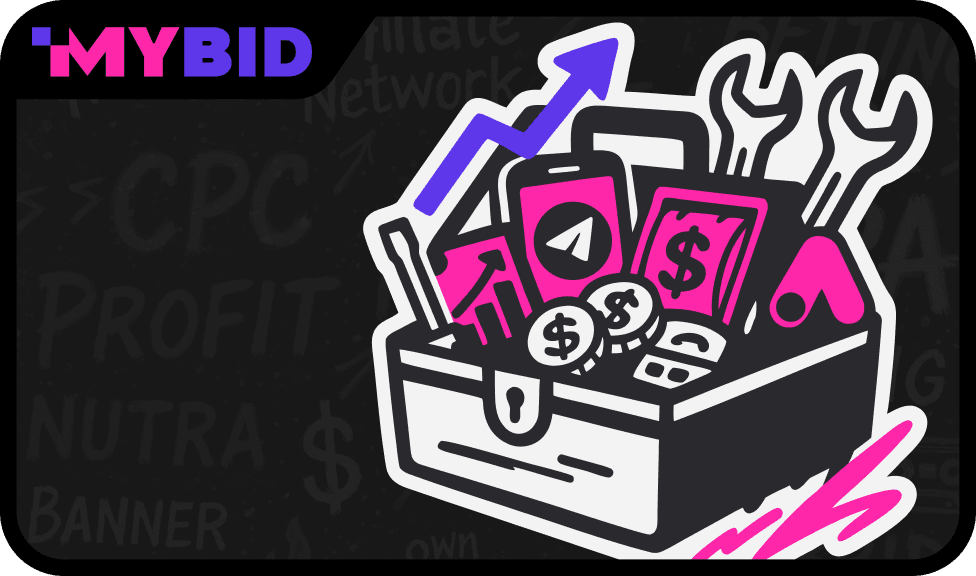
Competitor analysis isn’t just about collecting data—it’s your key to understanding the market, trends, and opportunities for growth. In traffic arbitrage, where competition often hits its peak, this analysis helps you stand out, optimize campaigns, and boost ROI. Let’s break down how to do it right and introduce the top tools that’ll keep you ahead of the game.
Looking to squeeze maximum value from every click? MyBid means reliability, lightning‑fast setup, and full control over your campaigns. With our top‑tier PopUnder and TMA traffic, results start flowing from day one. Contact our Advertiser Manager here
Competitor analysis is the systematic study of strategies, tools, and results used by other arbitrageurs in your niche. It lets you:
1. Spot successful offers and advertising channels.
2. Find gaps in competitors’ strategies.
3. Adapt best practices for your campaigns.
4. Predict market trends.
Without this analysis, you risk wasting your budget on ineffective offers or missing out on popular trends.

Start by finding arbitrageurs working with similar offers, traffic sources, or target audiences. Use keywords, social media, forums, and CPA networks to spot them.
Use specialized tools to gather info about:
1. Traffic sources (organic, paid ads, social media).
2. Keywords and SEO strategies.
3. Ad creatives and landing pages.
4. Audience demographics.
Study competitors’ creatives: What emotions do they evoke? What’s their CTA? How are their landing pages designed? This reveals what works in your niche.
Compare metrics like CTR, CR, and CPM. If their numbers are higher, dig deeper: Is it the offer, traffic, or creatives?
Use data to forecast which offers or channels will gain traction. For example, if competitors are testing TikTok traffic, it might be time to jump in.

A powerhouse for SEO analysis, keyword research, and competitor monitoring.
1. Features: Traffic analysis, rank tracking, backlink research, site audits.
2. Case Study: Use SEMrush to find keywords driving competitors’ traffic and target those gaps.
The go-to for backlink analysis and SEO.
1. Features: Backlink database, domain analysis, keyword research.
2. Tip: Find low-DR, high-traffic sites for link-building opportunities.
Tools for SEO audits and competitor analysis.
1. Features: Domain Authority scores, keyword analysis, site health reports.
2. Example: Compare the strength of competitors’ backlinks vs. yours.
Specializes in PPC and SEO competitor analysis.
1. Features: Ad history, keyword tracking, budget estimates.
2. Case Study: SpyFu reveals expensive keywords competitors target—perfect for low-budget campaigns.
Analyze competitors’ traffic and audience.
1. Features: Traffic sources, geography, site comparisons.
2. Tip: Discover which forums or blogs drive traffic to competitors.
Content analysis and social media monitoring.
1. Features: Viral content detection, mention tracking.
2. Example: Find competitors’ top-performing articles and create even better content.
Social media stats made simple.
1. Features: Follower growth, engagement rates, forecasts.
2. Tip: Track competitors’ TikTok or YouTube activity—key for traffic trends.
Audience behavior insights.
1. Features: Demographics, behavioral patterns.
2. Example: See which sites competitors’ audiences visit most—and advertise there.
Use SEMrush or Ahrefs to find competitors’ top offers. Check their CR in CPA networks—if they’re popular, launch similar ones.
SpyFu or iSpionage show competitors’ budgets. If their CPM is higher than yours, test alternative platforms.
If competitors ignore video traffic, try YouTube or TikTok campaigns.

MyBid’s Popunder is SEO-safe, even for sites with Google warnings. We deliver quality traffic, optimize for high CTR and conversion, and support every launch with a dedicated manager.
Connect with MyBid managers today — publishers and advertisers alike deserve marketing that drives results, not just racks up impressions.
Competitor analysis in traffic arbitrage is an investment in growth. Use SEMrush for SEO, SpyFu for PPC, Social Blade for social trends—and you’ll always stay ahead.